engine MAZDA MODEL TRIBUTE 4WD 2001 User Guide
[x] Cancel search | Manufacturer: MAZDA, Model Year: 2001, Model line: MODEL TRIBUTE 4WD, Model: MAZDA MODEL TRIBUTE 4WD 2001Pages: 232, PDF Size: 1.74 MB
Page 40 of 232
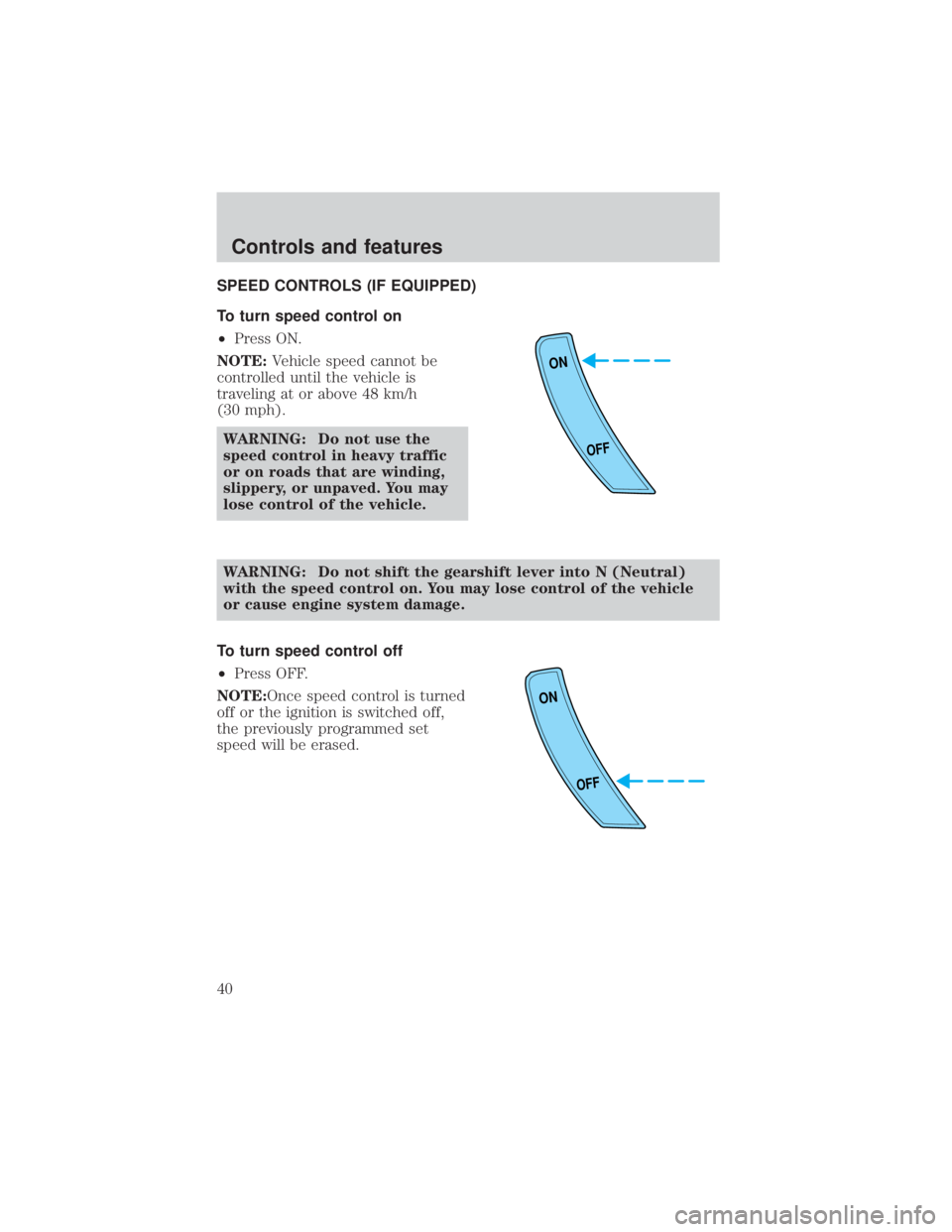
SPEED CONTROLS (IF EQUIPPED)
To turn speed control on
²Press ON.
NOTE: Vehicle speed cannot be
controlled until the vehicle is
traveling at or above 48 km/h
(30 mph).
WARNING: Do not use the
speed control in heavy traffic
or on roads that are winding,
slippery, or unpaved. You may
lose control of the vehicle.
WARNING: Do not shift the gearshift lever into N (Neutral)
with the speed control on. You may lose control of the vehicle
or cause engine system damage.
To turn speed control off
² Press OFF.
NOTE:Once speed control is turned
off or the ignition is switched off,
the previously programmed set
speed will be erased.
ON
OFF
ON
OFF
Controls and features
40
Page 43 of 232

To disengage speed control
²Depress the brake pedal or
² Depress the clutch pedal
(if equipped).
NOTE:Disengaging the speed
control will not erase the previously
programmed set speed.
NOTE:Fully depressing the clutch
pedal may cause a flare in engine
RPM as the throttle is returned to
idle. This is normal.
NOTE:Pressing OFF will erase the
previously programmed set speed.
ON
OFF
Controls and features
43
Page 61 of 232
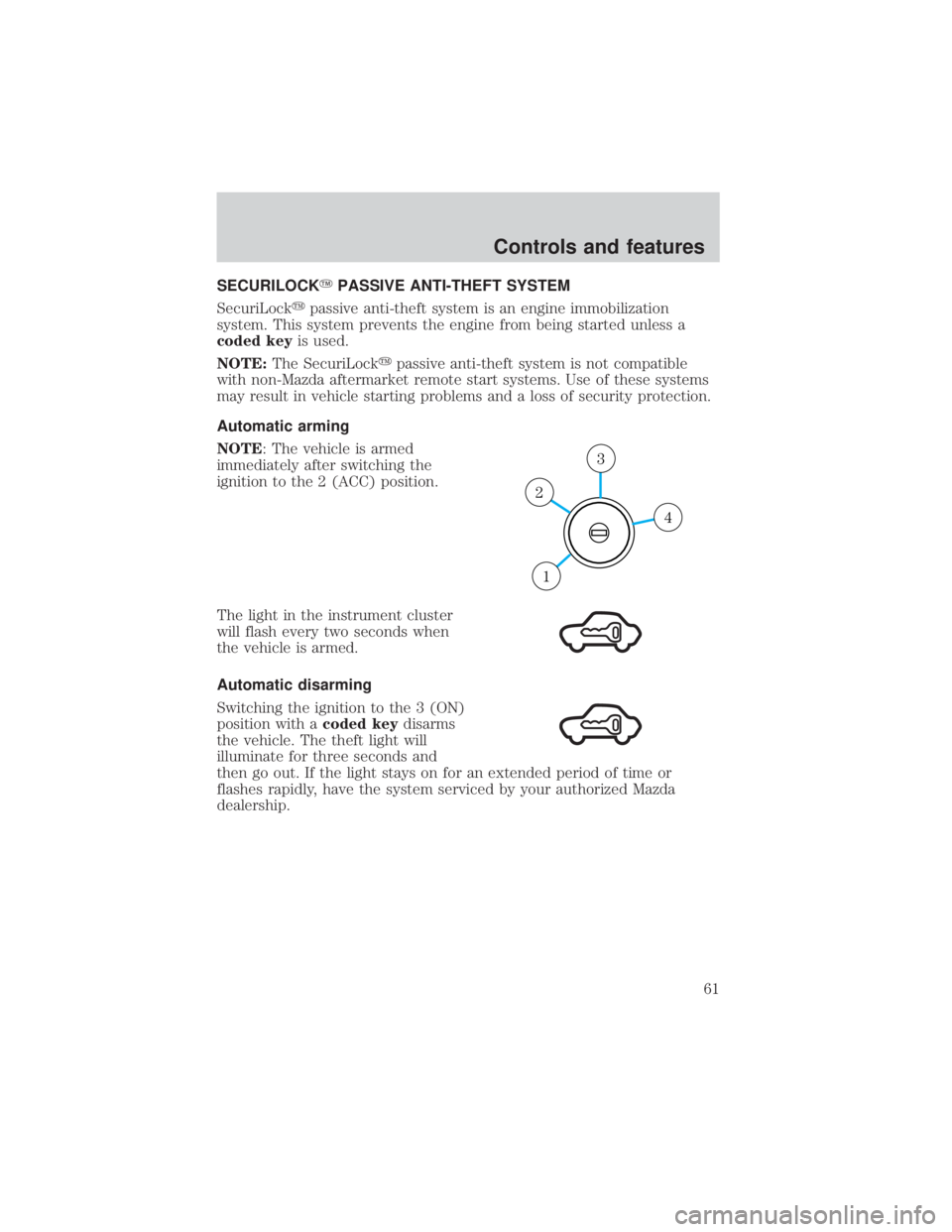
SECURILOCKYPASSIVE ANTI-THEFT SYSTEM
SecuriLock ypassive anti-theft system is an engine immobilization
system. This system prevents the engine from being started unless a
coded key is used.
NOTE: The SecuriLock ypassive anti-theft system is not compatible
with non-Mazda aftermarket remote start systems. Use of these systems
may result in vehicle starting problems and a loss of security protection.
Automatic arming
NOTE: The vehicle is armed
immediately after switching the
ignition to the 2 (ACC) position.
The light in the instrument cluster
will flash every two seconds when
the vehicle is armed.
Automatic disarming
Switching the ignition to the 3 (ON)
position with a coded keydisarms
the vehicle. The theft light will
illuminate for three seconds and
then go out. If the light stays on for an extended period of time or
flashes rapidly, have the system serviced by your authorized Mazda
dealership.
4
3
2
1
Controls and features
61
Page 62 of 232
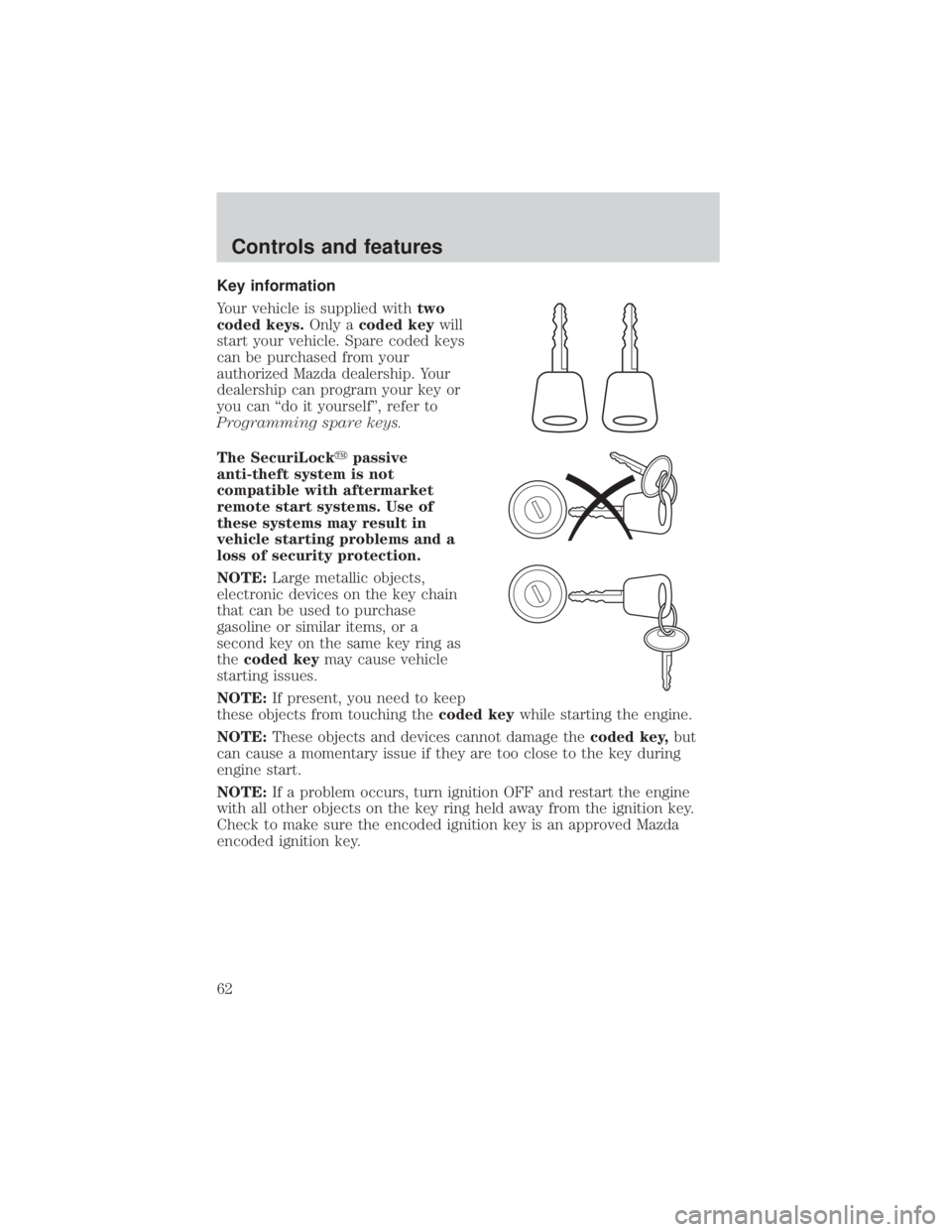
Key information
Your vehicle is supplied withtwo
coded keys. Only acoded key will
start your vehicle. Spare coded keys
can be purchased from your
authorized Mazda dealership. Your
dealership can program your key or
you can ªdo it yourselfº, refer to
Programming spare keys.
The SecuriLock ypassive
anti-theft system is not
compatible with aftermarket
remote start systems. Use of
these systems may result in
vehicle starting problems and a
loss of security protection.
NOTE: Large metallic objects,
electronic devices on the key chain
that can be used to purchase
gasoline or similar items, or a
second key on the same key ring as
the coded key may cause vehicle
starting issues.
NOTE: If present, you need to keep
these objects from touching the coded keywhile starting the engine.
NOTE: These objects and devices cannot damage the coded key,but
can cause a momentary issue if they are too close to the key during
engine start.
NOTE: If a problem occurs, turn ignition OFF and restart the engine
with all other objects on the key ring held away from the ignition key.
Check to make sure the encoded ignition key is an approved Mazda
encoded ignition key.
Controls and features
62
Page 63 of 232

If your keys are lost or stolen you
will need to do the following:
²Use your spare key to start the
vehicle. or
² Have your vehicle towed to an
authorized Mazda dealership. .
The key codes will need to be
erased from your vehicle and new key codes will need to be re-coded.
Replacing coded key can be very costly and you may want to store an
extra programmed key away from the vehicle in a safe place to prevent
an unforeseen inconvenience.
WARNING: If an unprogrammed key is used in the ignition it
will cause a ªNO STARTº condition.
Programming spare keys
A maximum of eight keys can be coded to your vehicle. Only
SecuriLock ykeys can be used. To program a coded keyyourself, you
will need two previously programmed coded keys(keys that already
operate your vehicle's engine) and the new unprogrammed key(s) readily
accessible for timely implementation of each step in the procedure.
If two previously programmed coded keys are not available, you must
bring your vehicle to your authorized Mazda dealership to have the spare
coded key(s) programmed.
NOTE: Please read and understand the entire procedure before you
begin.
NOTE: This procedure must be completed within the specified times. If
not completed within the specified time period, the reprogramming
procedure must be restarted from the beginning.
Controls and features
63
Page 64 of 232

1. Insert the first previouslyprogrammed coded keyinto
the ignition and turn the
ignition from 2 (ACC) to 3 (ON)
(maintain ignition in 3 (ON) for
at least one second).
2. Turn ignition to 1 (LOCK) and remove the first coded key
from the ignition.
3. Within ten seconds of turning the ignition to 2 (ACC), insert the second previously programmed
coded key into the ignition and turn the ignition from 2 (ACC) to 3
(ON) (maintain ignition in 3 (ON) for at least one second but no
more than ten seconds).
4. Turn the ignition to 1 (LOCK) and remove the second coded key
from the ignition.
5. Within 20 seconds of turning the ignition to 2 (ACC), insert the new unprogrammed key (new key/valet key) into the ignition and turn
the ignition from 2 (ACC) to 3 (ON) (maintain ignition in 3 (ON) for
at least one second). This step will program your new key to a coded
key.
6. To program additional new unprogrammed key(s), repeat this procedure from step 1.
If successful, the new coded key(s) will start the vehicle's engine and the
theft indicator will illuminate for three seconds and then go out.
If not successful, the new coded key(s) will not start the vehicle's engine
and the theft indicator will flash on and off and you may repeat steps 1
through 6. If failure repeats, bring your vehicle to your authorized Mazda
dealership to have the new spare key(s) programmed.
4
3
2
1
Controls and features
64
Page 102 of 232
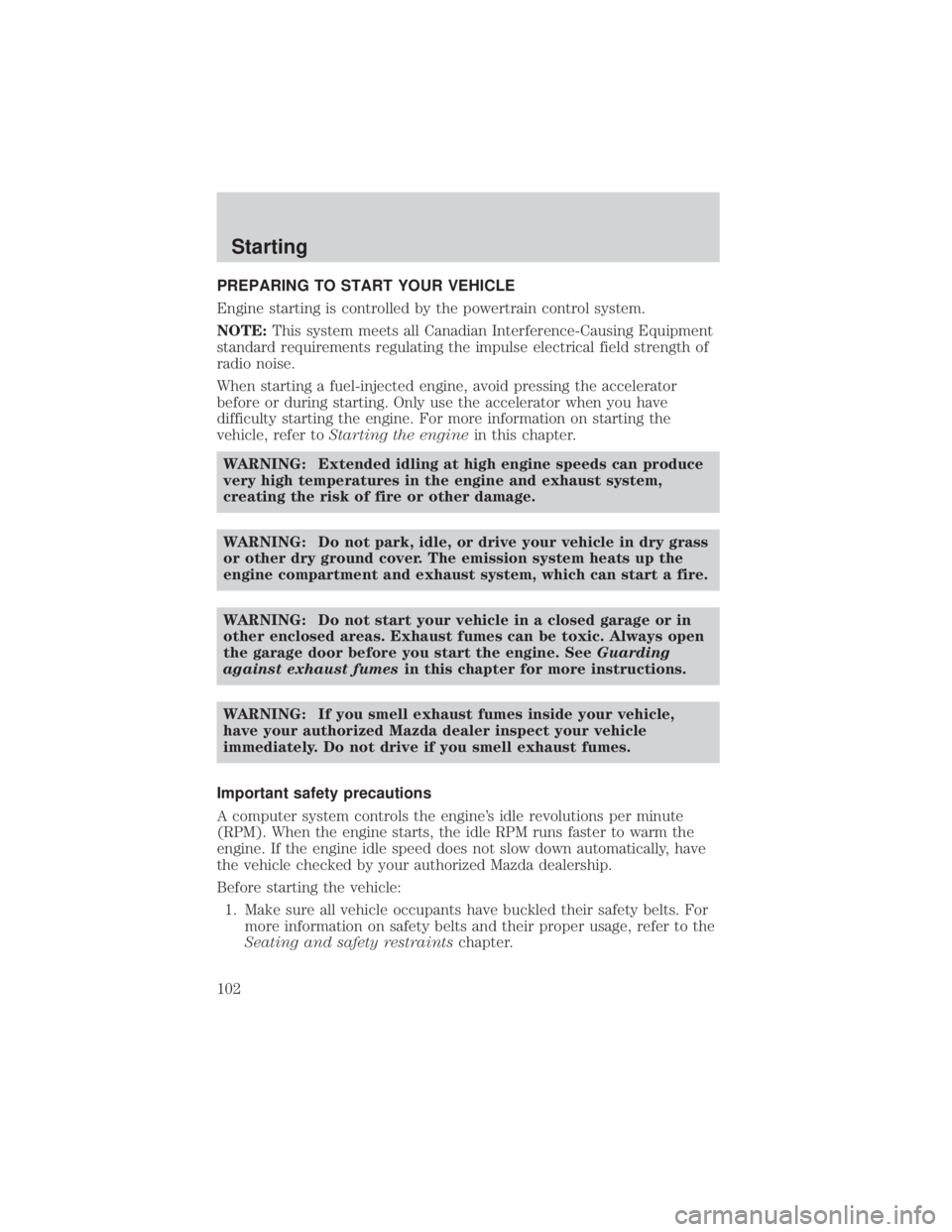
PREPARING TO START YOUR VEHICLE
Engine starting is controlled by the powertrain control system.
NOTE:This system meets all Canadian Interference-Causing Equipment
standard requirements regulating the impulse electrical field strength of
radio noise.
When starting a fuel-injected engine, avoid pressing the accelerator
before or during starting. Only use the accelerator when you have
difficulty starting the engine. For more information on starting the
vehicle, refer to Starting the engine in this chapter.
WARNING: Extended idling at high engine speeds can produce
very high temperatures in the engine and exhaust system,
creating the risk of fire or other damage.
WARNING: Do not park, idle, or drive your vehicle in dry grass
or other dry ground cover. The emission system heats up the
engine compartment and exhaust system, which can start a fire.
WARNING: Do not start your vehicle in a closed garage or in
other enclosed areas. Exhaust fumes can be toxic. Always open
the garage door before you start the engine. See Guarding
against exhaust fumes in this chapter for more instructions.
WARNING: If you smell exhaust fumes inside your vehicle,
have your authorized Mazda dealer inspect your vehicle
immediately. Do not drive if you smell exhaust fumes.
Important safety precautions
A computer system controls the engine's idle revolutions per minute
(RPM). When the engine starts, the idle RPM runs faster to warm the
engine. If the engine idle speed does not slow down automatically, have
the vehicle checked by your authorized Mazda dealership.
Before starting the vehicle: 1. Make sure all vehicle occupants have buckled their safety belts. For more information on safety belts and their proper usage, refer to the
Seating and safety restraints chapter.
Starting
102
Page 105 of 232
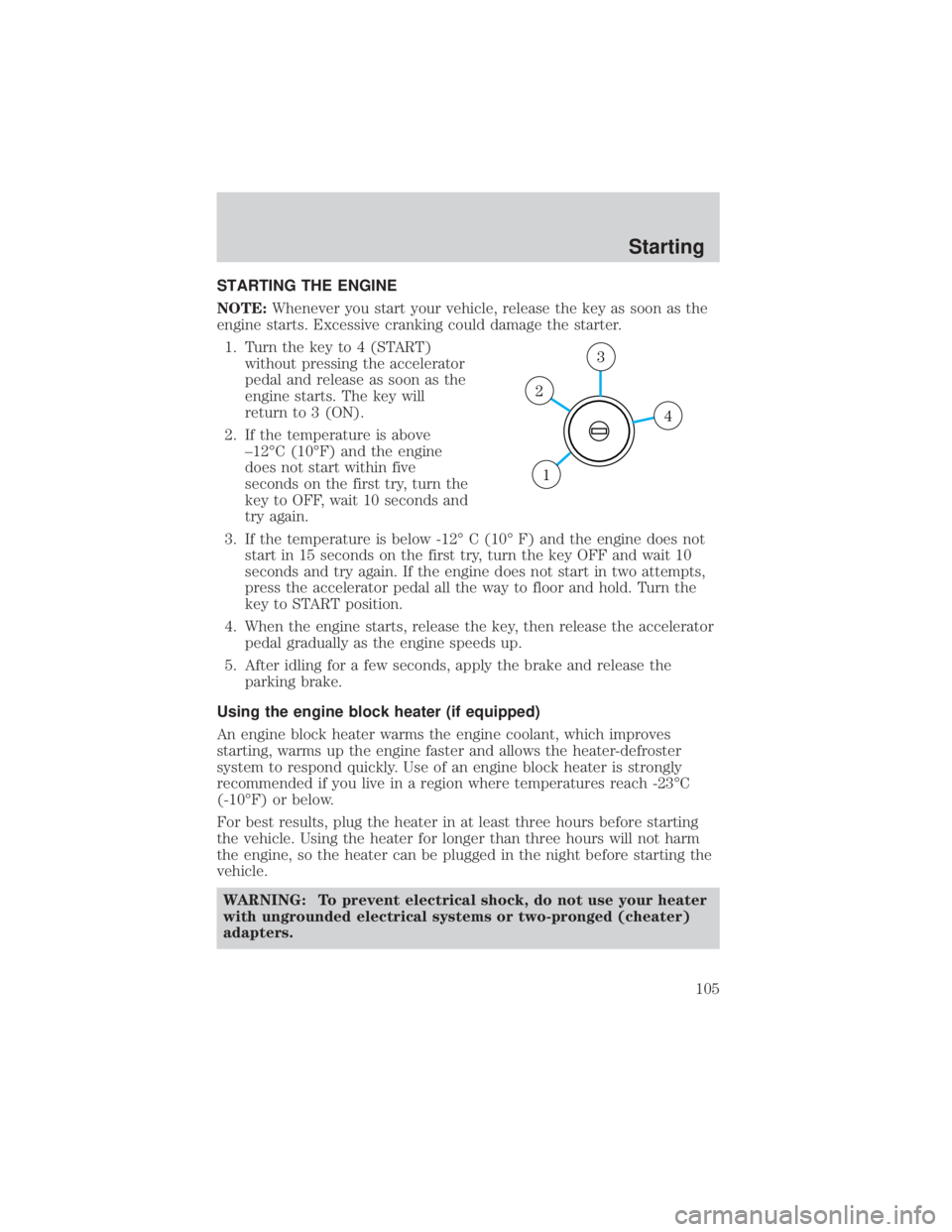
STARTING THE ENGINE
NOTE:Whenever you start your vehicle, release the key as soon as the
engine starts. Excessive cranking could damage the starter.
1. Turn the key to 4 (START) without pressing the accelerator
pedal and release as soon as the
engine starts. The key will
return to 3 (ON).
2. If the temperature is above ±12ÉC (10ÉF) and the engine
does not start within five
seconds on the first try, turn the
key to OFF, wait 10 seconds and
try again.
3. If the temperature is below -12É C (10É F) and the engine does not start in 15 seconds on the first try, turn the key OFF and wait 10
seconds and try again. If the engine does not start in two attempts,
press the accelerator pedal all the way to floor and hold. Turn the
key to START position.
4. When the engine starts, release the key, then release the accelerator pedal gradually as the engine speeds up.
5. After idling for a few seconds, apply the brake and release the parking brake.
Using the engine block heater (if equipped)
An engine block heater warms the engine coolant, which improves
starting, warms up the engine faster and allows the heater-defroster
system to respond quickly. Use of an engine block heater is strongly
recommended if you live in a region where temperatures reach -23ÉC
(-10ÉF) or below.
For best results, plug the heater in at least three hours before starting
the vehicle. Using the heater for longer than three hours will not harm
the engine, so the heater can be plugged in the night before starting the
vehicle. WARNING: To prevent electrical shock, do not use your heater
with ungrounded electrical systems or two-pronged (cheater)
adapters.
4
3
2
1
Starting
105
Page 106 of 232
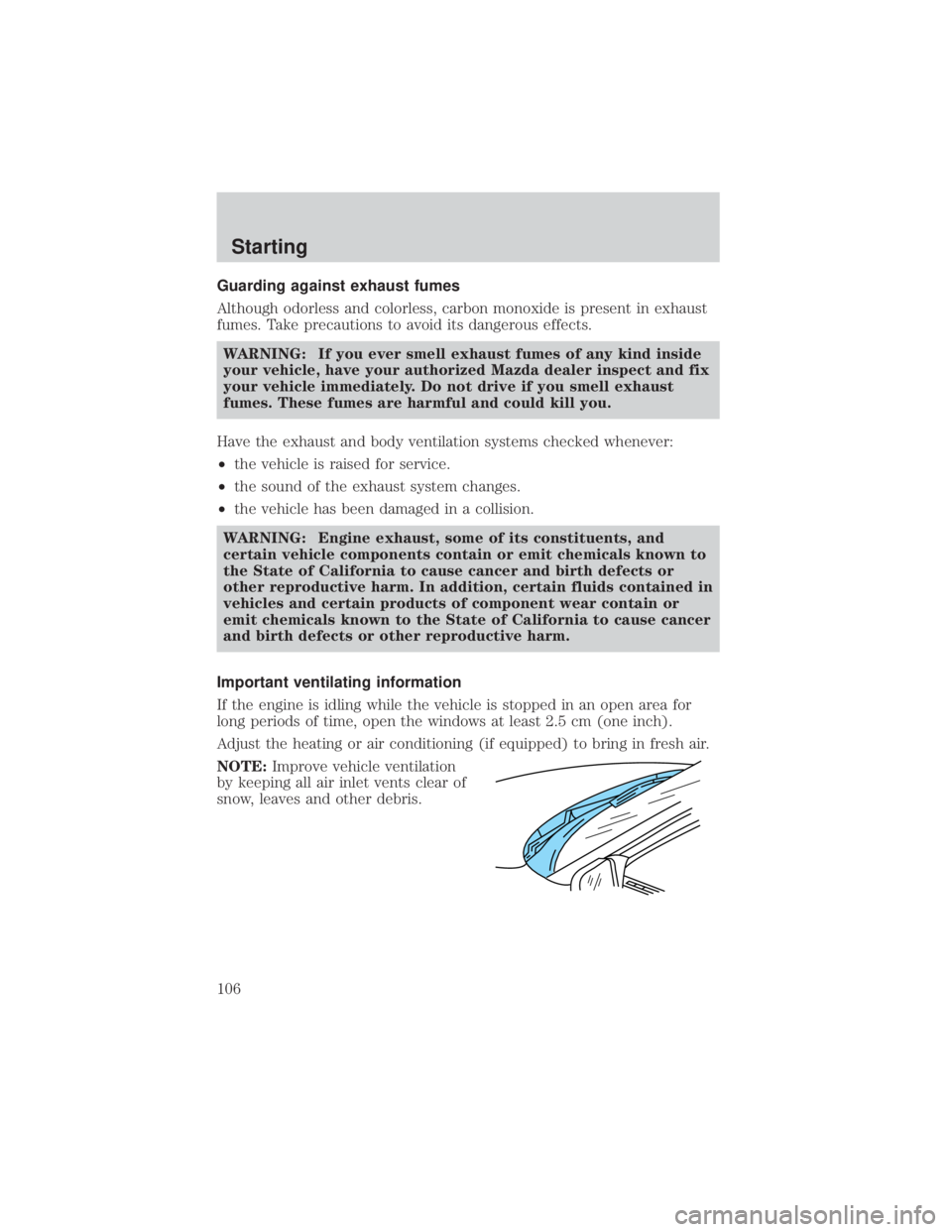
Guarding against exhaust fumes
Although odorless and colorless, carbon monoxide is present in exhaust
fumes. Take precautions to avoid its dangerous effects.WARNING: If you ever smell exhaust fumes of any kind inside
your vehicle, have your authorized Mazda dealer inspect and fix
your vehicle immediately. Do not drive if you smell exhaust
fumes. These fumes are harmful and could kill you.
Have the exhaust and body ventilation systems checked whenever:
² the vehicle is raised for service.
² the sound of the exhaust system changes.
² the vehicle has been damaged in a collision.
WARNING: Engine exhaust, some of its constituents, and
certain vehicle components contain or emit chemicals known to
the State of California to cause cancer and birth defects or
other reproductive harm. In addition, certain fluids contained in
vehicles and certain products of component wear contain or
emit chemicals known to the State of California to cause cancer
and birth defects or other reproductive harm.
Important ventilating information
If the engine is idling while the vehicle is stopped in an open area for
long periods of time, open the windows at least 2.5 cm (one inch).
Adjust the heating or air conditioning (if equipped) to bring in fresh air.
NOTE: Improve vehicle ventilation
by keeping all air inlet vents clear of
snow, leaves and other debris.
Starting
106
Page 107 of 232
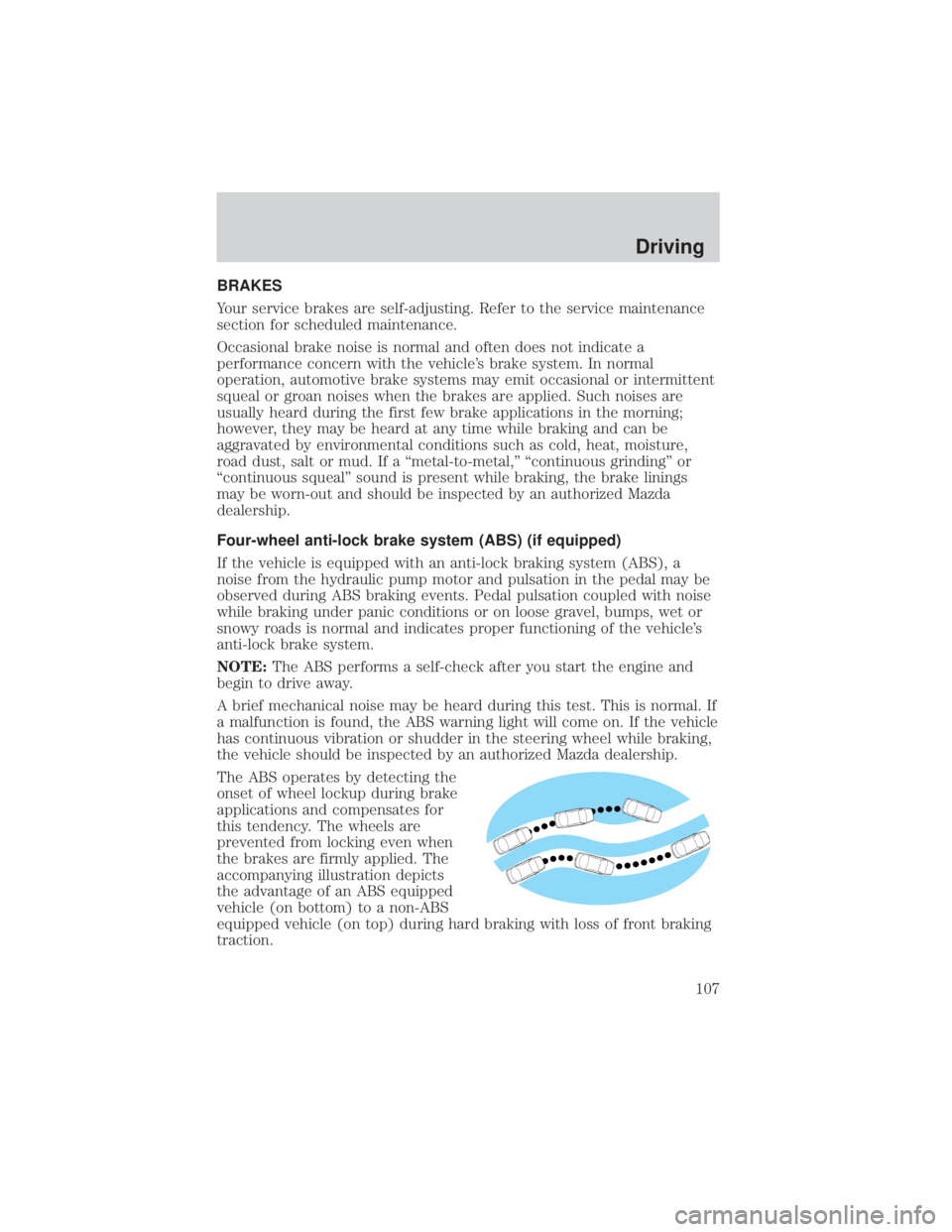
BRAKES
Your service brakes are self-adjusting. Refer to the service maintenance
section for scheduled maintenance.
Occasional brake noise is normal and often does not indicate a
performance concern with the vehicle's brake system. In normal
operation, automotive brake systems may emit occasional or intermittent
squeal or groan noises when the brakes are applied. Such noises are
usually heard during the first few brake applications in the morning;
however, they may be heard at any time while braking and can be
aggravated by environmental conditions such as cold, heat, moisture,
road dust, salt or mud. If a ªmetal-to-metal,º ªcontinuous grindingº or
ªcontinuous squealº sound is present while braking, the brake linings
may be worn-out and should be inspected by an authorized Mazda
dealership.
Four-wheel anti-lock brake system (ABS) (if equipped)
If the vehicle is equipped with an anti-lock braking system (ABS), a
noise from the hydraulic pump motor and pulsation in the pedal may be
observed during ABS braking events. Pedal pulsation coupled with noise
while braking under panic conditions or on loose gravel, bumps, wet or
snowy roads is normal and indicates proper functioning of the vehicle's
anti-lock brake system.
NOTE:The ABS performs a self-check after you start the engine and
begin to drive away.
A brief mechanical noise may be heard during this test. This is normal. If
a malfunction is found, the ABS warning light will come on. If the vehicle
has continuous vibration or shudder in the steering wheel while braking,
the vehicle should be inspected by an authorized Mazda dealership.
The ABS operates by detecting the
onset of wheel lockup during brake
applications and compensates for
this tendency. The wheels are
prevented from locking even when
the brakes are firmly applied. The
accompanying illustration depicts
the advantage of an ABS equipped
vehicle (on bottom) to a non-ABS
equipped vehicle (on top) during hard braking with loss of front braking
traction.
Driving
107